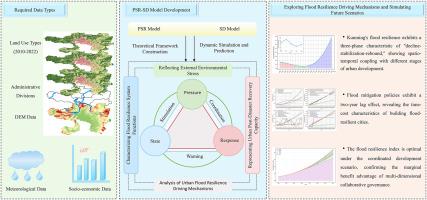Dynamic evolution and scenario-based prediction of urban flood resilience: A system dynamics modeling approach in Kunming, China
IF 8.4
2区 环境科学与生态学
Q1 ENVIRONMENTAL SCIENCES
引用次数: 0
Abstract
The interplay between global climate change and urbanization has exacerbated urban flood disaster risks. However, disaster prevention efforts are often hampered by an insufficient understanding of flood mechanisms and their drivers. To address this issue, this study combines the Pressure-State-Response (PSR) framework with System Dynamics (SD) to develop a coupled PSR-SD model that spans the entire disaster cycle. Focusing on the main urban area of Kunming, China, this study established a dynamic evaluation index system for flood resilience from 2010 to 2030, systematically analyzing its intrinsic driving mechanisms. Five development scenarios—business-as-usual, economic development priority, environmental protection priority, extreme climate challenge, and coordinated development—were designed to quantitatively project flood resilience evolution trends under distinct pathways from 2023 to 2030. Key findings include: (1) Kunming's flood resilience evolution exhibits a three-phase trajectory (“decline-stabilization-recovery”), demonstrating spatiotemporal coupling with urban developmental stages. (2) A 2-year policy effect lag period exists for flood control engineering measures, revealing temporal cost characteristics in resilience-oriented urban development. (3) Multi-scenario simulations indicate that the coordinated development scenario achieves the optimal resilience index (0.8807) by 2030, outperforming the extreme climate scenario by 18.12 %, confirming the marginal flood prevention benefit advantages of multidimensional coordinated governance. This study further discusses the proactive significance of integrated governance strategies in enhancing urban flood resilience, providing dynamic decision-making support for resilient city planning.

昆明城市洪水恢复力的动态演变与情景预测——基于系统动力学的建模方法
全球气候变化与城市化的相互作用加剧了城市洪涝灾害风险。然而,由于对洪水机制及其驱动因素了解不足,防灾工作往往受到阻碍。为了解决这个问题,本研究将压力-状态-响应(PSR)框架与系统动力学(SD)相结合,开发了一个跨越整个灾难周期的耦合PSR-SD模型。以昆明主城区为研究对象,建立了2010 - 2030年昆明主城区洪水恢复力动态评价指标体系,系统分析了其内在驱动机制。设计了5个发展情景,即“一切照老”、“经济发展优先”、“环境保护优先”、“极端气候挑战”和“协调发展”,定量预测了2023 - 2030年不同路径下的洪水恢复力演变趋势。主要发现包括:(1)昆明市洪水恢复力演化呈现“下降-稳定-恢复”的三期发展轨迹,与城市发展阶段存在时空耦合。(2)防洪工程措施存在2年的政策效应滞后期,揭示了城市弹性发展的时间成本特征。(3)多情景模拟结果表明,到2030年,协调发展情景的抗洪能力指数达到最优(0.8807),比极端气候情景高出18.12%,证实了多维协调治理的防洪边际效益优势。本研究进一步探讨了综合治理策略在增强城市抗洪能力方面的积极意义,为抗洪能力城市规划提供动态决策支持。
本文章由计算机程序翻译,如有差异,请以英文原文为准。
求助全文
约1分钟内获得全文
求助全文
来源期刊

Journal of Environmental Management
环境科学-环境科学
CiteScore
13.70
自引率
5.70%
发文量
2477
审稿时长
84 days
期刊介绍:
The Journal of Environmental Management is a journal for the publication of peer reviewed, original research for all aspects of management and the managed use of the environment, both natural and man-made.Critical review articles are also welcome; submission of these is strongly encouraged.
 求助内容:
求助内容: 应助结果提醒方式:
应助结果提醒方式:


